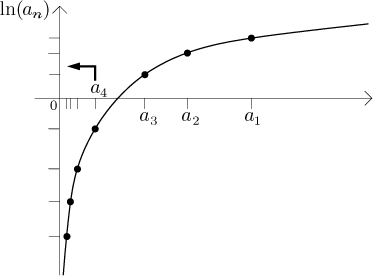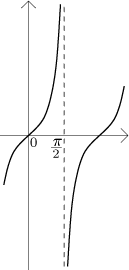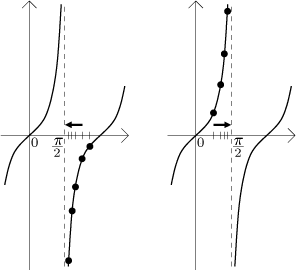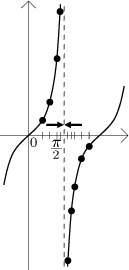Algebra of limits (with infinity)
What follows is a list of algebra expressions that can be used for
calculating limits. It is an extension of the usual algebra. We also mention
indeterminate expressions here. They are dealt with in more detail
here. Be sure to look at Notes at
the end for proper understanding of the rules, especially at the very last
note.
Here you find a brief list of the
limit algebra if you want just a summary.
Addition/subtraction:
Real numbers add/subtract in the usual way.
Infinity behaves nicely in most cases:
∞ ± L = ∞
for all real L,
∞ + ∞ = ∞.
Indeterminate expression:
∞ − ∞.
Multiplication/division:
Real numbers multiply in the usual way, also division works as usual as
long as the denominator is not equal to zero.
1/0+ = ∞
and
1/0- = −∞,
where 0+ stands for a sequence tending to
zero whose terms are all positive and 0- stands for a sequence
tending to zero whose terms are all negative (in fact, it is enough to have
the positivity/negativity valid only at the "end" of the given sequence, that
is, after dropping its "beginning", a finite number of terms). See the note
at the end.
Infinity behaves nicely in the following cases:
∞⋅L = ∞
and ∞/L = ∞
for all positive L,
∞⋅L = −∞
and ∞/L = −∞
for all negative L,
L/∞ = 0
for all real L,
∞⋅∞ = ∞.
Indeterminate expressions:
∞⋅0,
 , and
, and
 .
.
The expressions L/0 for L not zero and
∞/0 are usually not included
among indeterminate expressions, but they do belong there, since they can
yield three distinct answers:
∞,
−∞ and
"DNE" (Does Not Exist).
For details see Notes below.
Powers:
Real numbers work in powers in the usual way; in particular, the power
AB works as usual for positive A. When
A is not positive, one has to be cautious, in particular 00
is an indeterminate expression (see below).
Infinity behaves nicely in the following cases:
∞L = ∞
for all positive L,
∞L = 0
for all negative L,
L∞ = ∞
if L > 1,
L∞ = 0
if |L| < 1, and
L∞ DNE if
L < −1,
L−∞ = 1/L∞ = (1/L)∞,
so
L−∞ = 0 if
|L| > 1,
L−∞ = ∞
if 0 < L < 1, and
L−∞ DNE
if −1 < L < 0.
∞∞ = ∞.
Indeterminate expressions:
1∞,
00,
∞0.
Some elementary functions:
e∞ = ∞, therefore
e−∞ = 1/e∞ = 1/∞ = 0.
ln(∞) = ∞ and
ln(0+) = −∞,
where 0+ stands for a sequence tending to zero whose
terms are all positive (or at least they are positive if the first few are
dropped).
arctan(∞) = π/2,
arctan(−∞) = −π/2.
Notes
A note on the meaning of the limit algebra and some indeterminate
stuff
In the above equalities any given symbol does not stand for an actual number;
rather, it symbolizes sequences whose limit is equal to this specific symbol.
For instance, 2⋅3 = 6 in this context does not refer to real
numbers, but it reads: "When a sequence converging to 2 is multiplied by a
sequence converging to 3, the resulting sequence converges to 6." This
explains why the limit algebra sometimes fails in examples that would seem
obvious if we were dealing with numbers. For instance, one to any power is
one, but one to infinity is an indeterminate expression! Why?
One to infinity is in fact a shortcut for a sequence that converges to 1
raised to a sequence that converges to infinity. Since we perform the
operation term by term, we obtain the sequence of powers
{an bn},
where the bases an are eventually close to 1, but
they need not be exactly one. For instance, they might all be slightly more
than one. Since they are raised to huge numbers (the exponents
bn tend to infinity), they may yield big answers and
the resulting sequence may even converge to infinity. It all depends on
balance. If the exponents become really big before the bases have a chance to
get close to 1, then "one to infinity" may be a big number. On the other
hand, if the bases get really close to 1 really fast, while exponents are
growing to infinity slowly, then the closeness of bases to 1 may outweight
the growth of exponents and "one to infinity" could be close to one.
Similarly, if the bases are less than one and tend to one slowly, while
exponents get big really fast, then "one to infinity" may be small, even
zero.
Similar balance decides the outcome of other indeterminate expressions, for
instance the outcome of
∞ − ∞
depends on which of the infinities becomes large faster.
A note on 1/0
It is enough to investigate 1/0, since expressions L/0 and infinity
divided by zero behave in exactly the same way. The basic idea is that one
divided by a really tiny number is a really huge number whose sign depends on
the sign of the divisor. Since with a tiny number it is just a small change
from positive to negative, it follows that such a small change in the
denominator will make a huge change in the outcome: the large number changes
sign (for instance, 1/0.0001 = 10,000, while
1/-0.0001 = −10,000).
Recall that "0" stands for some sequence
{an} that
tends to zero. The outcome of 1/0 depends on the signs of
an. If all an are positive
(this is denoted by 0+ in the limit algebra, it is actually enough
if the terms become positive after the first few are dropped), it follows
that we always divide "almost one" (recall that "1" stands for some sequence
bn tending to 1) by a small positive number,
obtaining a huge positive answer. Therefore the resulting limit should be
infinity. On the other hand, if all an are negative
(this is denoted by 0- in the limit algebra, it is actually enough
if the terms become negative after the first few are dropped), it follows
that we always divide "almost one" by a tiny negative number, obtaining a
negative number that in absolute value is very huge. Therefore the resulting
limit should be negative infinity. In this way we obtain the two formulas for
1/0 in the limit algebra above:
1/0+ = ∞
and
1/0- = −∞.
The third alternative is that as we follow the sequence
an towards its end, no sign prevails; that is, no
matter how far we go along the sequence, there are always negative and
positive an further on. This can be also expressed
like this: It is not possible to make the sequence have the same sign by
ignoring its beginning, that is, by dropping a finite number of its terms.
Since the sequence an tends to zero and
bn is about one for large n, the numbers
bn /an in absolute
value grow to infinity, but the signs keep changing from plus to minus and
back in some way; thus
bn /an yields an
oscillating sequence, with the size of oscillation growing. In such a case
the outcome is that the limit of the sequence
bn /an does not exist.
The conclusion is that when we see the type 1/0, we have to investigate the
sign of the sequence in the denominator. If we find out that a certain sign
eventually prevails, we can use the limit algebra. If we find that no sign
prevails, they keep changing, the answer is that the limit DNE. If we are
unable to investigate the signs, then we have to give up on this particular
case of 1/0.
For some examples of this behaviour, see
indeterminate expressions.
An important note on one-sided limits
In this note we put together the two ideas from the previous notes to explain
why sometimes we need to consider one-sided limits.
The fact that a number in limit algebra is not exactly this number, but a
symbol for a convergent sequence, allows us to do things which could not be
done with numbers. For instance, we know that we cannot substitute the
number 0 to the function 1/x2. However, in the limit
algebra we have
1/02 = ∞
(almost, as we will
explain). Why? 0 stands for a sequence
{an} that
converges to zero. If this sequence satisfies the condition that
an are different from zero, then
an2 are positive numbers converging to
zero, so 1/an2 must go to infinity. We
can actually write
02 = 0+ and use the
result from the previous note.
Sometimes when we try to substitute a number representing a convergent
sequence into a function, we have to be careful and do extra work. For
instance, what is the outcome of ln(0)? Recall that logarithm is defined only
for positive numbers, so here one has to look closely at the sequence
{an} represented by "0". In order to make sense,
its terms have to satisfy
an > 0. Then
they can be substituted into logarithm and
ln(an)
goes to −∞.

We marked the sequence on the real line, the values of
ln(an) appear on the vertical axis.
We had a notation for such "0", in the previous note we called it
0+, and we just argued that
ln(0+) = −∞.
These considerations are used quite often and deserve a formal definition.
Definition (one-sided limits)
Let {an} be a sequence that converges to a real
number A.
If an > A for all n, we say that
{an} converges to A from the right. We denote
it
an→A+,
and in the limit algebra we would use the
symbol A+ for such a sequence.
If an < A for all n, we say that
{an} converges to A from the left. We denote
it
an→A-,
and in the limit algebra we would use the
symbol A- for such a sequence.
In the following pictures we show how one-sided limits look like.

We saw two most typical examples when one-sided limits are useful,
expressions 1/0 and ln(0). In fact, whenever you get these two expressions,
you do have to investigate whether the 0 is one-sided, otherwise you cannot
make any conclusion regarding the outcome. There are more examples like this.
Every time you are trying to substitute some A into a function and you
run into trouble, you should ask whether the situation could be helped if
A is of the one-sided type.
Example: What is the outcome of tan(π/2)?
We know that tangent is not defined at
π/2,
which shows that we should investigate further. Since
we know how tangent looks like,

we see that this is exactly the situation where one-sided limits can help. If
we imagine examples of sequences tending to
π/2
from the right and from the left,

we should be able to make the correct guess:
tan((π/2)+) = −∞,
tan((π/2)-) = ∞.
So when faced with
tan(π/2),
the sequence inside tangent has to be investigated in more
detail. If the limit is one-sided, the outcome is as above. If the sequence
keeps jumping to the right and left of
π/2,
the limit does not exist.

![]() , and
, and
![]() .
.




